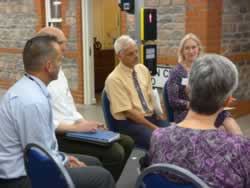Child Injury HIT aims to set national standard
The Child Injury Health Integration Team (CIPIC HIT) launched on Monday 2 September with a bold statement of intent to position Bristol at the forefront of child injury prevention and care. Julie Mytton, Co-ordinating Director of CIPIC, said during her o
- 9th September 2013
The Child Injury Health Integration Team (CIPIC HIT) launched on Monday 2 September with a bold statement of intent to position Bristol at the forefront of child injury prevention and care. Dr Julie Mytton, Co-ordinating Director of CIPIC, said during her opening presentation that “There’s no reason why Bristol can’t be setting the national standard for the integration of child injury, prevention, first response, care and rehabilitation.”

The event saw 45 child injury experts and practitioners from across Bristol gather to hear from the topic leads for the newly launched HIT. The aim of the event was to create a network for attendees, making the most of the group’s considerable skills and experience. The event took place at the Lifeskills Centre (external link) at the Create Centre (external link). Lifeskills is an interactive safety education centre, built as a realistic village, which has been developed to teach people how to deal with potentially difficult or dangerous situations, whilst in a safe environment.
Julie, who is also the University of the West of England’s Associate Professor of Child Health, facilitated the day and introduced the HIT, its work and who’s involved.
A number of speakers helped showcase the good practice already happening in Bristol. Fergal Monsell, Consultant in Orthopaedic Surgery at University Hospitals Bristol NHS Foundation Trust (UHB) spoke on adolescent fractures, and how clinical decisions taken early on can affect a patient’s life for years to come. Amber Young, Consultant Paediatric Anaesthetist at North Bristol NHS Trust, gave a presentation on the Healing Foundation’s Children’s Burns Research Centre. Consultant in Paediatric Emergency Medicine at University Hospitals Bristol NHS Foundation Trust, Mark Lyttle, spoke on tackling injuries in the Children’s Emergency Department. Toity Deave, UWE’s Associate Professor in Child and Family Health, talked about the Keeping Children Safe at Home study, a community based injury prevention programme. Rob Benington, Bristol City Council’s Injury Prevention Co-ordinator, talked about how to engage practitioners and the public outside the NHS.
Group sessions on diverse topics including public involvement, education, data issues, acute care and rehabilitation made the most of the assembled professionals’ knowledge and experience and helped to identify priorities for the HIT. The launch also saw the start of a consultation period on the strategy for public involvement in the HIT.
Julie said of the event: “I was delighted with the interest and enthusiasm shown at the launch event, and feel confident that we are going to be able to form new and helpful collaborations through the HIT. There was a lot of discussion on issues to tackle and potential solutions to explore.”






